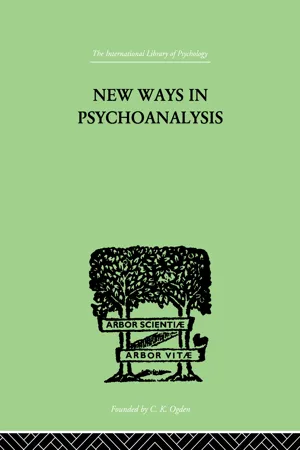
This is a test
- 316 pages
- English
- ePUB (mobile friendly)
- Available on iOS & Android
eBook - ePub
New Ways in Psychoanalysis
Book details
Book preview
Table of contents
Citations
About This Book
First Published in 1999. This is Volume XVI of twenty-eight in the Psychoanalysis series. Written around 1939 the purpose of this book is not to show what is wrong with psychoanalysis, but through eliminating the debatable elements, to enable psychoanalysis to develop to the height of its potentialities; that psychoanalysis should outgrow the limitations set by its being an instinctive and a genetic psychology.
Frequently asked questions
At the moment all of our mobile-responsive ePub books are available to download via the app. Most of our PDFs are also available to download and we're working on making the final remaining ones downloadable now. Learn more here.
Both plans give you full access to the library and all of Perlego’s features. The only differences are the price and subscription period: With the annual plan you’ll save around 30% compared to 12 months on the monthly plan.
We are an online textbook subscription service, where you can get access to an entire online library for less than the price of a single book per month. With over 1 million books across 1000+ topics, we’ve got you covered! Learn more here.
Look out for the read-aloud symbol on your next book to see if you can listen to it. The read-aloud tool reads text aloud for you, highlighting the text as it is being read. You can pause it, speed it up and slow it down. Learn more here.
Yes, you can access New Ways in Psychoanalysis by Karen Horney in PDF and/or ePUB format, as well as other popular books in Medicine & Health Care Delivery. We have over one million books available in our catalogue for you to explore.
Information
Index
Abraham, Karl, 99, 102, 104, 243
Accusations against others, sources of, 241, 242; repression of, 242, 243; and self-recriminations, 243
Adler, Alfred, 73, 140, 268
Age-phobia in women, 115 ff.
Aggression, and destruction instinct, 130; indiscriminate use of the term, 130
Aim-inhibited drives, Freud’s concept of, 53; critique of, 58, 59
Alexander, Franz, 228, 247
Alienation from self, and narcissistic trends, 99, 100; versus Freud’s concept of “ego,” 189; its significance for therapy, 190; and perfectionistic trends, 218; and masochistic trends, 252; and neurotic trends, 278; and impairment of productivity, 278
Allen, Frederick, 140
Analysis, patient’s motivations in coming to, 287; reinforcement of motivations during, 288; constructive aspect of, 288, 289, 290; change in personality through, 290, 291
Anxiety, Freud’s concept of, 57; its relation to physiological processes, 193; versus fear, 195; related to “super-ego,” 196; and neurotic trends, 198, 199; and helplessness, 195, 203, 204; hostility and, 199, 200; potential and manifest, 202; comparison of my concept with Freud’s, 201, 202; influence of Freud’s concept on therapy, 204, 205; therapy and my interpretation of, 205, 206; as fear of “super ego” according to Freud, 223, 224; as fear of being unmasked according to my interpretation. 224, 225
Balint, Michael, 89
Basic anxiety, comparison with Freud’s “real anxiety,” 75; definition of, 74 ff.; genesis of, 75 ff.; relation to neurotic trends, 75 ff.; versus “Urangst,” 202, 203; versus manifest anxiety, 202; its role in neuroses, 276, 277
Benedict, Ruth, 172, 274
Biological orientation, Freud’s, 38; its expression in instinct theories, 47; influence on concept of feminine psychology, 118, 119; biological versus sociological orientation, 168 ff.
Bisexuality, Freud’s concept of, 101; in woman’s psychology, 101, 102; in man’s psychology, 110; my objection to, 110
Blitzsten, N. L., 95
Breuer, Joseph, 147
Carroll, Paul Vincent, 220
Change of personality, patient’s attitude toward; 290, 291; analyst’s “attitude toward, 291, 292
Character structure, versus repetitive experiences, 283, 284
Childhood experiences, Freud’s concept of influence of, 32, 33; debatable aspects, 32, 33; and cultural factors, 170
Childhood factors, relevant for genesis of neuroses, 9, 10; emphasis on, 138, 139; and therapeutic expectations, 139
Childhood memories, curative value of, 139, 140; debatable aspects of use as explanatory principle, 151; retrieving of, 283, 284
Compulsory standards, and feeling of superiority, 220; and inhibition in work, 223
Conflicts in neuroses, Freud’s view of, 24; critique of, 24; attempts at their solution, 201; their nature, 276, 277, 278
Constitutional factor...
Table of contents
- Cover
- Half Title
- Title Page
- Copyright Page
- Table of Contents
- Introduction
- I. Fundamentals of Psychoanalysis
- II. Some General Premises of Freud’s Thinking
- III. The Libido Theory
- IV. The Oedipus Complex
- V. The Concept of Narcissism
- VI. Feminine Psychology
- VII. The Death Instinct
- VIII. The Emphasis on Childhood
- IX. The Concept of Transference
- X. Culture and Neuroses
- XI. The “Ego” and the “Id”
- XII. Anxiety
- XIII. The Concept of the “Super-Ego”
- XIV. Neurotic Guilt Feelings
- XV. Masochistic Phenomena
- XVI. Psychoanalytic Therapy
- Index